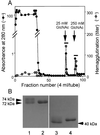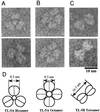Horseshoe crab acetyl group-recognizing lectins involved in innate immunity are structurally related to fibrinogen
- PMID: 10468566
- PMCID: PMC17846
- DOI: 10.1073/pnas.96.18.10086
Horseshoe crab acetyl group-recognizing lectins involved in innate immunity are structurally related to fibrinogen
Abstract
We have characterized and cloned newly isolated lectins from hemolymph plasma of the horseshoe crab Tachypleus tridentatus, which we named tachylectins 5A and 5B (TLs-5). TLs-5 agglutinated all types of human erythrocytes and Gram-positive and Gram-negative bacteria. TLs-5 specifically recognize acetyl group-containing substances including noncarbohydrates; the acetyl group is required and is sufficient for recognition. TLs-5 enhanced the antimicrobial activity of a horseshoe crab-derived big defensin. cDNA sequences of TLs-5 indicated that they consist of a short N-terminal Cys-containing segment and a C-terminal fibrinogen-like domain with the highest sequence identity (51%) to that of mammalian ficolins. TLs-5, however, lack the collagenous domain found in a kind of "bouquet arrangement" of ficolins and collectins. Electron microscopy revealed that TLs-5 form two- to four-bladed propeller structures. The horseshoe crab is equipped with a unique functional homologue of vertebrate fibrinogen, coagulogen, as the target protein of the clotting cascade. Our observations clearly show that the horseshoe crab has fibrinogen-related molecules in hemolymph plasma and that they function as nonself-recognizing lectins. An ancestor of fibrinogen may have functioned as a nonself-recognizing protein.
Figures








References
-
- Janeway C A., Jr Cold Spring Harbor Symp Quant Biol. 1989;54:1–13. - PubMed
-
- Medzhitov R, Janeway C A., Jr Cell. 1997;91:295–298. - PubMed
-
- Weis W I, Drickamer K. Structure (London) 1994;2:1227–1240. - PubMed
-
- Turner M W. Immunol Today. 1996;17:532–540. - PubMed
-
- Ichijo H, Hellman U, Wernstedt C, Gonez L J, Claesson-Welsh L, Heldin C-H, Miyazono K. J Biol Chem. 1993;268:14505–14513. - PubMed
Publication types
MeSH terms
Substances
Associated data
- Actions
- Actions
- Actions
LinkOut - more resources
Full Text Sources
Other Literature Sources
Molecular Biology Databases

